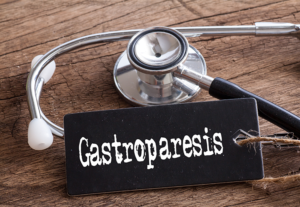
Diabetes is one of the leading causes of both chronic kidney disease (CKD) and gastroparesis. As a result, it is not uncommon for dialysis dietitians to come across a patient with diabetic gastroparesis who has a complicated medical picture and is at high risk for malnutrition and poor glycemic control.
Read on to learn more about this challenging condition.
How does diabetes cause gastroparesis?
In the setting of poorly controlled diabetes, high blood sugar leads to nerve damage, also called neuropathy, throughout the body. Neuropathy can affect one or more nerves that control aspects of normal gastric function like gastric accommodation and gastric contractions.
Unfortunately, once neuropathy has developed, the damage has been done and it may be irreversible. People with diabetic gastroparesis often do not see an improvement in delayed gastric emptying or related symptoms even after glycemic control improves.
What are the consequences of diabetic gastroparesis?
All types of gastroparesis can lead to the same consequences and symptoms.
Symptoms include:
- Nausea and vomiting
- Early satiety and postprandial fullness
- Loss of appetite
- Bloating and distention
- Upper abdominal pain
Consequences of these symptoms include:
- Dehydration
- Food avoidance
- Malnutrition
- Poor quality of life
In addition to the above, diabetic gastroparesis can lead to worse glycemic control due to a mismatch in post-prandial glucose absorption
and insulin release.
Are there special nutritional considerations for dialysis patients with diabetic gastroparesis?
Yes, there are two major potential issues to keep in mind relating to nutrition for these patients.
First is phosphate control. Because certain phosphate binders are less effective at low pH levels, optimal phosphate binding may not occur if the medication does not empty into the small intestine along with the phosphate-containing food. Lanthanum carbonate and sucroferric oxyhydroxide are examples of phosphate binders that have a wider pH for phosphate binding and may be good options for these patients.
Second is malnutrition risk. Combining the high rate of nutrient loss seen in dialysis with the poor nutritional intake associated with gastroparesis put patients at extremely high risk of protein-energy malnutrition. These patients are likely strong candidates for multiple forms of nutrition support which includes liquid oral nutrition supplements, which will be easier to digest than solids, and the introduction of intradialytic parenteral nutrition (IDPN) for hemodialysis or intraperitoneal nutrition (IPN) for peritoneal dialysis patients.
Utilizing these unique forms of parenteral nutrition allows the dialysis patient to get a big boost in protein and calories without exacerbating gastroparesis symptoms or causing significant changes to blood sugar. This is because this form of nutrition infuses directly into the bloodstream, bypassing the stomach all together, and formulas use a low dextrose concentration.
Because diabetic gastroparesis does not typically resolve even after good glycemic control is established, these patients may be dealing with symptoms for years. It’s important for dietitians to be prepared to aid these patients with symptom management and nutrition support to optimize their health and quality of life.
For more information on gastroparesis management, check out these resources:
- PCA Monthly Webinar: Gastroparesis Update
- Patient and Clinician handouts on our Clinician Portal:
To learn more about how IDPN and IPN can support your malnourished dialysis patients, visit pcacorp.com .
